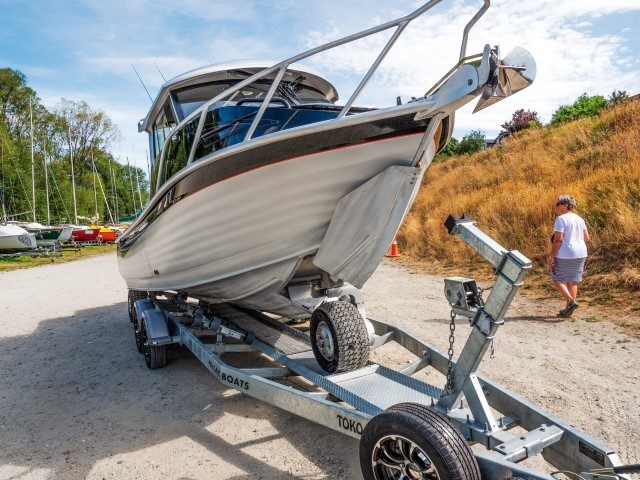‘Behemoth’ is a word which springs to mind or, perhaps more nautically, ‘leviathan’.
- Wheels completely retract inside the boat
- Uncluttered cockpit
- Supplied fast charger recharges in two hours
- Quiet operation on land
- Useful run time allows multiple uses between charges
- Looks and behaves like any other McLay hardtop on the water
- Cabin space and berths compromised by front wheel housing









 Leaving the water reverses the procedure: as you approach the beach under engine power with the outboard partially tilted, lower the wheels until locked and apply electric power while still floating. As soon as all three wheels are in contact with the bottom, kill the outboard and drive up the beach. Once high and dry, the Raptor can be made to ‘kneel’ by retracting the wheels until it rests on its keel. Kneeling makes embarking and disembarking much easier and takes the strain off the undercarriage. It is recommended when storing your Raptor.McLay’s 741 Raptor looks and behaves like any other typical robust, practical and roomy McLay hardtop cruiser, but the addition of a thoroughly integrated Tectrax amphibious system sets it apart from the rest of the McLay range.
Leaving the water reverses the procedure: as you approach the beach under engine power with the outboard partially tilted, lower the wheels until locked and apply electric power while still floating. As soon as all three wheels are in contact with the bottom, kill the outboard and drive up the beach. Once high and dry, the Raptor can be made to ‘kneel’ by retracting the wheels until it rests on its keel. Kneeling makes embarking and disembarking much easier and takes the strain off the undercarriage. It is recommended when storing your Raptor.McLay’s 741 Raptor looks and behaves like any other typical robust, practical and roomy McLay hardtop cruiser, but the addition of a thoroughly integrated Tectrax amphibious system sets it apart from the rest of the McLay range.








